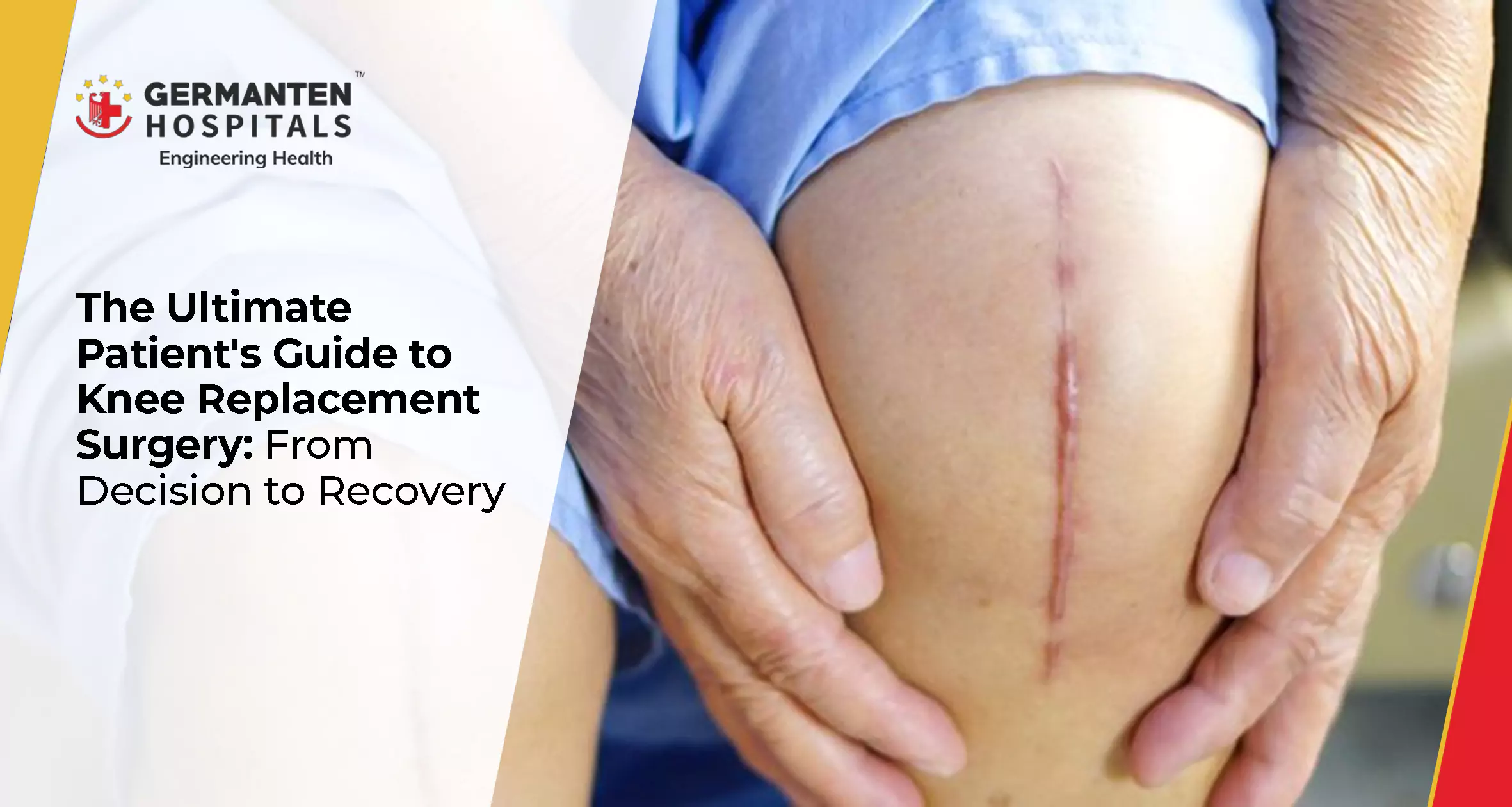Chronic knee pain can feel like an unwelcome guest that overstays its welcome, gradually impacting every aspect of your life. From simple activities like walking up the stairs to enjoying a leisurely stroll in the park, persistent knee pain can cast a long shadow. When conservative treatments no longer provide the relief you need, knee replacement surgery, also known as knee arthroplasty, emerges as a powerful, life-changing solution.
At Germanten Hospital, we believe that a well-informed patient is an empowered patient. This comprehensive guide is designed to walk you through the entire knee replacement journey, from understanding the signs that surgery might be necessary to navigating your recovery and embracing a more mobile, pain-free life.
Is It Time to Consider Knee Replacement? 10 Signs to Watch For
Making the decision to undergo surgery is significant. It's a conclusion often reached after months or even years of managing pain. Our orthopedic specialists at Germanten Hospital typically evaluate several factors to determine if a patient is a good candidate. You might be ready for a knee replacement if you identify with several of the following signs:
- 1. Chronic and Severe Pain: The most common reason patients seek this surgery is severe pain that persists even during rest. If your knee aches constantly and isn't relieved by over-the-counter medications, it's a clear signal.
- 2. Pain That Disrupts Sleep: When knee pain is so severe that it regularly wakes you up at night, it significantly impacts your overall health and quality of life.
- Interference with Daily Activities: Your life has become limited. Simple tasks like getting out of a chair, walking through a grocery store, or climbing stairs are now major, painful challenges.
- 4. Failure of Conservative Treatments: You have diligently tried other options—such as physical therapy, anti-inflammatory medications, steroid injections, and lifestyle modifications—but they no longer provide meaningful relief.
- 5. Significant Knee Stiffness and Immobility: Your knee's range of motion has become severely limited. You find it difficult to bend or fully straighten your knee, which affects your gait and mobility.
- 6. Chronic Swelling and Inflammation: Your knee is consistently swollen and inflamed, and rest or medication does little to reduce it. This indicates advanced joint degeneration.
- 7. Knee Deformity: You've noticed a change in your leg's appearance. The knee may have started to bow inwards or outwards ("knock-kneed" or "bow-legged") as the cartilage has worn away unevenly.
- 8. Knee Instability: You feel your knee might "give way" or buckle without warning. This instability not only causes pain but also puts you at a high risk for falls and further injury.
- 9. X-Rays Show Advanced Arthritis: A definitive sign is an X-ray that reveals severe cartilage loss, often described as "bone-on-bone" arthritis. This is when the protective cartilage has completely worn away.
- 10. Your Quality of Life is Suffering: Ultimately, the decision often comes down to this. When your knee pain dictates your schedule, prevents you from enjoying hobbies, and negatively impacts your mental well-being, it's time to explore a more permanent solution.
If these signs resonate with you, a consultation with an orthopedic expert is the next logical step.
The Research Behind Knee Replacement: A Trusted and Evolving Procedure
Knee replacement is one of the most successful and reliable procedures in modern medicine. The primary goal is to resurface the parts of the knee joint that have been damaged by arthritis or injury, thereby relieving pain and restoring function. Research and technological advancements have continually improved the procedure's outcomes and the longevity of the implants.
Studies show that for most people, knee replacement provides dramatic pain relief and a significantly improved quality of life. The complication rate is low, with serious issues like joint infection occurring in fewer than 2% of patients. Modern implants are incredibly durable; most can be expected to last for at least 15 to 20 years, and for many patients, they last a lifetime. This longevity is a testament to the advancements in materials science and surgical techniques. Furthermore, the evolution of the procedure to include minimally invasive techniques and robotic assistance—a cornerstone of our approach at Germanten Hospital—has led to even better outcomes, such as faster recovery and more precise implant placement.
Understanding the Knee Replacement Procedure: A Step-by-Step Overview
The surgery itself is a highly precise resurfacing of the joint, typically taking one to two hours. Here’s what happens after you are taken to the operating theatre:
- Step 1: Anesthesia: Your comfort and safety are paramount. You will receive either a general anesthetic (which puts you to sleep) or a spinal/epidural anesthetic that numbs the lower half of your body. Your surgeon may also inject a long-acting local anesthetic around the joint to help manage pain immediately after the surgery.
- Step 2: The Incision: The surgeon makes an incision down the front of the knee to access the joint. The length of this incision has become shorter over the years with the adoption of minimally invasive techniques.
- Step 3: Preparing the Bones: The surgeon carefully moves the kneecap (patella) to the side and removes the damaged cartilage and a small amount of underlying bone from the end of the thighbone (femur) and the top of the shinbone (tibia). They use precise instruments to shape the remaining bone surfaces to perfectly fit the new implant components.
- Step 4: Implanting the Artificial Components: Metal components are fitted to the end of the femur and the top of the tibia. These are typically secured with a specialized bone cement. A durable, medical-grade plastic spacer is then placed between the metal parts to create a smooth, gliding surface that mimics natural cartilage. In some cases, the undersurface of the kneecap is also resurfaced with a plastic button.
- Step 5: Final Checks and Closure: Before closing the incision, the surgeon will bend and flex your knee to ensure the implant is functioning correctly and that you have good alignment and stability. The incision is then closed with stitches or staples and covered with a sterile dressing.
The Road to Recovery: Your Journey After Surgery
Recovery is a process that requires patience and commitment, but the results are well worth the effort. The journey begins the moment you leave the operating room.
In the Hospital (Typically 1-3 Days): Your recovery starts almost immediately. A care team of nurses and physical therapists will help you get up and start walking, often within a few hours of your surgery, using a walker for support. Early movement is crucial to prevent blood clots and stiffness. A physical therapist will guide you through initial exercises to improve mobility and blood flow. Pain will be managed with medication to keep you comfortable.
The First Few Weeks at Home: You will likely go home after 1 to 3 days. During the first few weeks, you will need some help with daily tasks like cooking and cleaning. It is essential to diligently follow the home exercise program prescribed by your physical therapist to regain strength and range of motion.
- Pain and Swelling: Expect some pain and swelling for several weeks or even a few months. This is normal. Manage it by elevating your leg and applying ice packs for 10-20 minutes at a time, several times a day.
- Walking Aids: Most patients use a walker for the first few weeks, then progress to a cane as they feel more stable and confident.
Long-Term Recovery and a New Lease on Life: Full recovery takes time, often between six months to a year, but you will notice significant improvements along the way.
- By 6 Weeks: Most people can resume many normal daily activities and may be able to walk without an aid. Driving is often permitted around this time, but always check with your surgeon first.
- By 3-6 Months: You should be able to return to most low-impact activities. Many patients report feeling 80% improved by the six-month mark.
- Life with Your New Knee: Your new joint will allow you to enjoy activities like unlimited walking, swimming, golfing, and cycling with significantly less pain. High-impact activities like running or jumping are generally discouraged to protect the implant and ensure its longevity.
Our Commitment to Your Care
At Germanten Hospital, our orthopedic team, led by renowned surgeons with international training and experience, is dedicated to providing patient-centric care that combines clinical excellence with German precision technology. From your first consultation to your final follow-up appointment, we are your partners in health, committed to helping you reclaim your mobility and live a life free from chronic pain.



